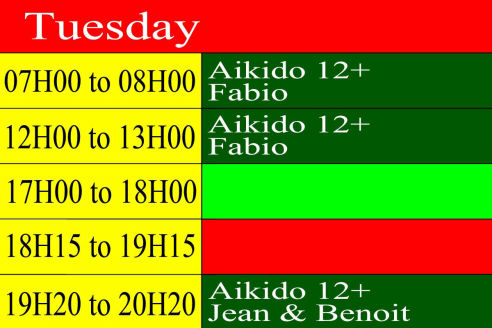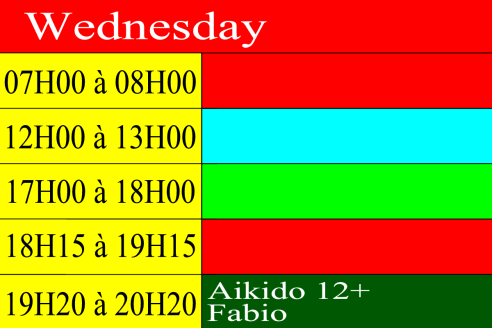





1. Double tenkan (tai Sabaki)
2. Tenkan
3. Mae ukemi
4. Ushiro ukemi
5. Yoko ukemi
6. Shikko
7. Aihanmi ikkyo omote & ura
8. Shomenuchi ikkyo omote & ura
9. Katate tori shihonage omote
1. Shomenuchi Ikkyo
2. Shomenuchi Iriminage
3. Katatetori Shihonage
4. Ryotetori Tenchinage
5. Tsuki Kotegaeshi
6. Ushiro Tekubitori Kotegaeshi
7. Morotetori Kokyuho
1. Shomenuchi Nikkyo
2. Yokomenuchi Shihonage
3. Tsuki Iriminage
4. Ushiro Tekubitori Sankyo
5. Ushiro Ryokatatori Kotegaeshi
6. Suwari waza Shomenuchi Ikkyo
7. Suwari waza Katatori Nikkyo
8. Suwari waza Katatori Sankyo
1. Yokomenuchi Iriminage (2 ways)
2. Yokomenuchi Kotegaeshi
3. Tsuki Kaitennage (uchi & soto)
4. Ushiro Ryokatatori Sankyo
5. Morotetori Iriminage (2 ways)
6. Shomenuchi Sankyo
7. Suwari waza
Shomenuchi Iriminage
8. Suwari waza Shomenuchi Nikkyo
9. Hanmi handachi
Katatetori Shihonage
10. Hanmi handachi Katatetori
kaiten nage
1. Shomenuchi Shihonage
2. Shomenuchi Kaitennage
3. Yokomenuchi Gokyo
4. Ushiro Tekubitori Shihonage
5. Ushiro Tekubitori Jujinage
6. Ushiro Kubishime Koshinage
7. Morotetori Nikkyo
8. Hanmi handanchi
Shomenuchi Iriminage
9. Hanmi handanchi
Katatetori Nikkyo
10. Hanmi handanchi
Yokomenuchi Kotegaeshi
11. Free style: 2 attackers
1. Katatori menuchi - 5 techniques
2. Yokomenuchi - 5 techniques
3. Morotetori - 5 techniques
4. Shomenuchi - 5 techniques
5. Ryotetori - 5 techniques
6. Koshinage - 5 techniques
7. Hanmi handachi ushiro
Waza - 5 techniques
8. Tantotori
9. Free style: 3 attackers
1. All of 1(st) kyu requirements
2. Tachitori
3. Jotori
4. Henka Waza
5. Free style: 4 attackers
1. All of shodan requirements
2. Tachitori - 2 attackers
3. Kaeshi Waza
4. Free style: 5 attackers
Subject of exam to be determined by
examiner at the time of the exam.

AIKIDO is composed of three ideograms, AI(合), which means union or meeting, KI(気), which can be interpreted as vital energy, and DO(道), which means path.
Morihei Ueshiba was born on December 14, 1883 in Tanabe, a town in the prefecture of Wakayama, Japan. After having studied numerous martial arts during his youth and being marked by several encounters, Morihei Ueshiba, who his students often called O’Sensei (which means Great Teacher) because of his great expertise in martial arts, gave his training a new direction by eliminating the notion of enemy and winner of a fight. He envisioned Aikido not only as the synthesis of his martial art training, but as an expression of universal peace as well.
合気道にはきまった型やスタイルがありません。その動きは自然の動きであり、動きの秘伝は奥が深く無限です。
There are various Aikido forms and styles. Its movements are inspired by nature whose secret is deep and infinite.